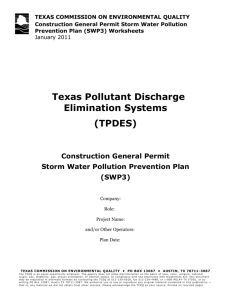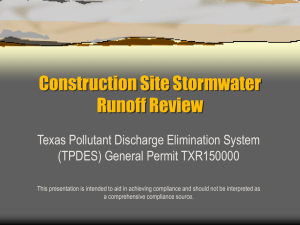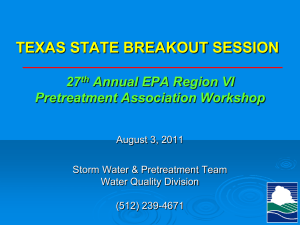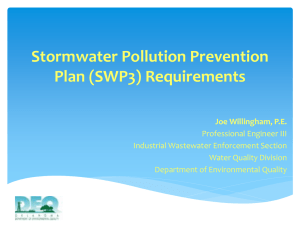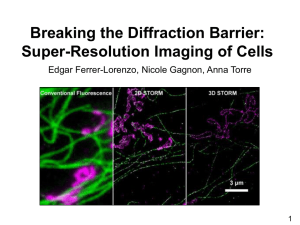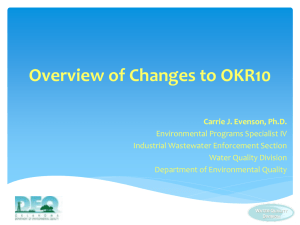Storm Water Industrial Compliance Inspection Report
advertisement
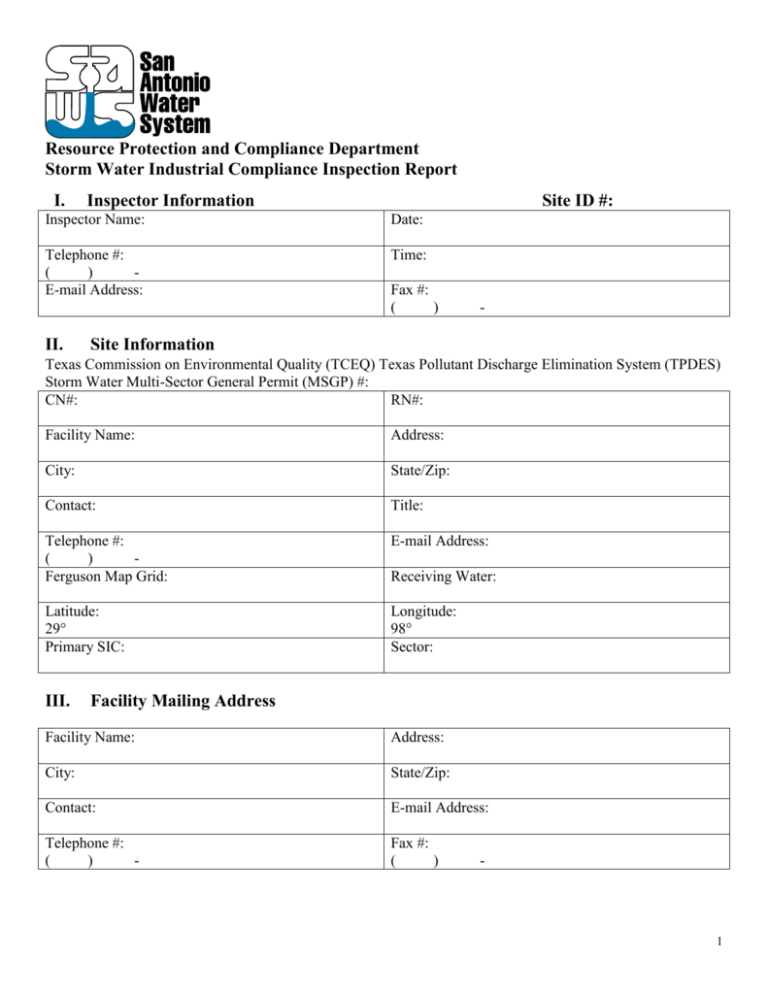
Resource Protection and Compliance Department Storm Water Industrial Compliance Inspection Report I. Inspector Information Site ID #: Inspector Name: Date: Telephone #: ( ) E-mail Address: Time: II. Fax #: ( ) - Site Information Texas Commission on Environmental Quality (TCEQ) Texas Pollutant Discharge Elimination System (TPDES) Storm Water Multi-Sector General Permit (MSGP) #: CN#: RN#: Facility Name: Address: City: State/Zip: Contact: Title: Telephone #: ( ) Ferguson Map Grid: E-mail Address: Latitude: 29° Primary SIC: Longitude: 98° Sector: III. Receiving Water: Facility Mailing Address Facility Name: Address: City: State/Zip: Contact: E-mail Address: Telephone #: ( ) - Fax #: ( ) - 1 IV. Permit Information Permit Information Yes No N/A Yes No N/A Yes No N/A Yes No N/A 1. Does the industry meet the SIC code requirements for the MultiSector Storm Water Discharge Permit? TPDES Part II, Section A(1) 2. Does the facility have a Multi-Sector Storm Water Discharge Permit? TPDES Part II, Section A(1) 3. Does the industry have a copy of the general permit in or attached to the SWP3? (except for non-related sections in Part V) TPDES Part III, Section A (8) 4. Has the San Antonio Water System received a copy of the facility’s Notice of Intent (NOI) and/or Notice of Coverage (NOC), and is it maintained on site? TPDES Part II, Section C (8) 5. Is the facility located over the Edwards Aquifer Recharge Zone (EARZ) or Contributing Zone (CZ)? TPDES Part II, Section B(8) 6. If the facility is located over the EARZ or CZ, is there a copy of an approved TCEQ Water Pollution Abatement Plan (WPAP) or Contributing Zone Plan (CZP) included with the SWP3? TPDES Part II, Section B(8) 7. Is the Maintenance Schedule in the WPAP or CZP being followed? TPDES Part II, Section B(8) V. Storm Water Pollution Prevention Plan (SWP3) A. Minimum Requirements of SWP3 1. Is the SWP3 on site and available for review? TPDES Part III, Section A (1) 2. Is the SWP3 signed and dated? TPDES Part II, Section C (3) B. Pollution Prevention Team 1. Does the SWP3 identify specific individuals or positions within the organization as members of the Pollution Prevention Team? TPDES Part III, Section A(2)(a) 2. Are Pollution Prevention Team Members responsibilities clearly outlined? TPDES Part III, Section A(2)(a)&(b) 3. If Pollution Prevention Team member’s responsibilities have changed, has the SWP3 been amended? TPDES Part III, Section A(2)(a)&(b) C. Non-Storm Water Discharges 1. Was an investigation of potential Non-Storm Water Discharges conducted (dry weather flows)? TPDES Part III, Section A(3)(b) 2. Does the certification include documentation of how the Inspection was conducted, results of any testing, dates of evaluation or tests, and the points observed during the investigation? TPDES Part III, Section A(3)(c) 3. Is there a properly signed Certification of Evaluation of the Storm Water System for Non-Storm Water Discharges prepared within 180 days of filing an NOI? TPDES Part III, Section A(3)(c) 4. Are all Non-Storm Water Discharges eligible for coverage? TPDES Part II, Section A(5) 2 C. Non-Storm Water Discharges (Cont.) Yes No N/A Yes No N/A Yes No N/A 5. If a Part of the separate storm system cannot be accessed to complete the evaluation, was a Notice of Deficiency sent to the TCEQ Enforcement Division within 180 days of NOI submission? TPDES Part III, Section A(3)(d) VI. Potential Pollutants and Sources D. Potential Pollutants and Sources 1. Inventory of Exposed Significant Material a. Is there a current listing of all materials handled, treated, processed, stored or disposed of in a manner that is currently exposed to Storm Water? (updated within 30 days following a significant change in types of Exposed Material or material management). TPDES Part III, Section A(4)(a) b. Is there an inventory of specific pollutants including a narrative description of all activities that could potentially be expected to contribute pollutants to Storm Water? (e.g., oil and grease, copper, wood shaving, lime, etc.) TPDES Part III, Section A (4)(a)&(b) c. Are loading and unloading areas described in narrative form (including areas where chemicals and other materials are transferred)? TPDES Part III, Section A(4)(b)(1) d. Are outdoor storage areas described in narrative form? TPDES Part III, Section A(4)(b)(2) e. Are outdoor processing areas described in narrative form? TPDES Part III, Section A(4)(b)(3) f. Is dust producing activities described in narrative form? TPDES Part III, Section A(4)(b)(4) g. Are onsite waste disposal areas described in narrative form? TPDES Part III, Section A(4)(b)(5) h. Are vehicle/equipment maintenance, cleaning and fueling areas described in narrative form? TPDES Part III, Section A(4)(b)(6) i. Are liquid storage tank areas described in narrative form? TPDES Part III, Section A(4)(b)(7) j. Are railroad sidings, tracks and rail cars described in narrative form? TPDES Part III, Section A(4)(b)(8) 2. Site Map a. Has a Site Map been developed? TPDES Part III, Section A(4)(c) b. Does the Site Map indicate the location of each outfall and each sampling point (if different from the outfall)? TPDES Part III, Section A(4)(c)(1) c. Are outlines of the drainage areas that are within the facility’s boundary and the direction of flow to each outfall leaving the facility’s boundary shown on the Site Map or included in narrative description? TPDES Part III, Section A(4)(b)&(c)(2) d. Are connections or discharges to Municipal Separate Storm Sewers shown on Site Map? TPDES Part III, Section A(4)(c)(3) 3 2. Site Map (Cont.) Yes No N/A Yes No N/A Yes No N/A Yes No N/A e. Are locations of all structures (e.g. building, garages, storage tanks) shown on Site Map? TPDES Part III, Section A(4)(c)(4) f. Are structural controls shown on Site Map? TPDES Part III, Section a (4) TPDES Part III, Section A(4)(c)(5) g. Are process wastewater treatment units (including ponds) shown on Site Map? TPDES Part III, Section A(4)(c)(6) h. Are bag houses and other air treatment units exposed to precipitation shown on Site Map? TPDES Part III, Section A(4)(c)(7) i. Are landfills, scrap yards, and surface water bodies (including wetlands) shown on Site Map? TPDES Part III, Section A(4)(c)(8) j. Are vehicle and equipment maintenance areas shown on Site Map? TPDES Part III, Section A(4)(c)(9) k. Are physical features that influence storm water runoff or contribute dry weather flow shown on Site Map? TPDES Part III, Section A(4)(c)(10) l. Are locations of reportable quantity spills or leaks [as defined by the 30 Texas Administrative Code (TAC) 327.2] occurring 3 years prior to the NOI being submitted shown on Site Map? TPDES Part III, Section A(4)(c)(11) m. Are processing areas, storage areas (containers, piles, other), material loading and unloading areas, and other locations where significant materials are expose to precipitation shown on Site Map? TPDES Part III, Section A(4)(c)(12) 3. Spills and Leaks a. Does the SWP3 contain a list of reportable quantity spills and leaks (as defined by the 30 TAC 327) of toxic or hazardous pollutants that occurred in areas exposed to precipitation during the three years prior to obtaining the NOI? TPDES Part III, Section A (4)(d) b. Is the list updated quarterly to include additional spills and leaks? TPDES Part III, Section A(4)(d) E. Pollution Prevention Measures & Controls 1. Good Housekeeping Measures a. Have good housekeeping procedures been developed and implemented? TPDES Part III, Section A(5)(a) b. Does good housekeeping include measures to reduce or eliminate the exposure of garbage and refuse to precipitation or Storm Water runoff? TPDES Part III, Section A(5)(a) 2. Spill Prevention and Response Measures a. Has the facility developed specific Spill Prevention and Cleanup Techniques and incorporated them in the SWP3? TPDES Part III, Section A(5)(b)(1-8) b. Are drums, tanks, containers, etc. clearly labeled? TPDES Part III, Section A(5)(b)(3) 4 3. Erosion Control Yes No N/A Yes No N/A Yes No N/A Yes No N/A a. Have measures been developed to address soil erosion at the facility? TPDES Part III, Section A(5)(c) b. Have controls such as soil stabilization through vegetative cover, contouring slopes, paving and installation of structural controls been evaluated? TPDES Part III, Section A(5)(c) 4. Maintenance Program for Structural Controls a. Are Storm Water structural controls (ex: oil/water separators, catch basins, sediment ponds, grass swales, berms, dikes, etc.) regularly inspected? TPDES Part III, Section A (5)(d) b. Have maintenance frequencies been established for structural controls and are they adequate? TPDES Part III, Section A(5)(d) c. Is mechanical equipment (i.e. storm water pump) that is part of storm water structural controls regularly inspected? TPDES Part III, Section A(5)(d) d. Are inspections of structural controls conducted by qualified personnel? TPDES Part III, Section A(5)(d) e. Are written records maintained of structural control’s maintenance including estimated volumes removed from catch basins and sediment ponds? TPDES Part III, Section A (5)(d) and Section E(5) (f) regarding removal of sludge or other waste from storm water units. 5. Best Management Practices (BMP) a. Are BMP site and sector specific? TPDES Part III, Section (5)(e) 6. Employee Training a. Has training on the SWP3 been conducted for all employees who are responsible for implementing or maintaining the activities in the SWP3 conducted at least annually and are written records maintained?(i.e. date, attendance sheet, material covered) TPDES Part III, Section A(5)(f) b. Are there written records of an education program for employees not directly responsible for SWP3 activities? (At a minimum, informed of basic goal of the SWP3.) TPDES Part III, Section A(5)(f) c. Does employee training include proper material management and handling practices for specific chemicals, fluids, and other materials used or commonly encountered at the facility? TPDES Part III, Section A(5) (f) (1) d. Does employee training include proper spill prevention methods/techniques? TPDES Part III, Section A(5)(f)(2) e. Does employee training include location of materials and equipment necessary for spill cleanup? TPDES Part III, Section A (5)(f)(3) f. Does the employee training include spill clean up techniques? TPDES Part III, Section A (5)(f)(4) g. Does employee training include proper spill reporting procedures? TPDES Part III, Section A (5)(f)(5) h. Does employee training include good housekeeping measures, BMPs, and goals of the SWP3? TPDES Part III, Section A(5)(f)(6) 5 7. Periodic Inspections Yes No N/A Yes No N/A Yes No N/A a. Are qualified individuals conducting periodic inspections of industrial activities? TPDES Part III, Section (5)(g) b. Are inspections conducted quarterly (or more frequently as required by sector) and documented? TPDES Part III, Section A(5)(g) c. Does the inspection identify existing BMPS that are not properly or completely implemented? TPDES Part III, Section A(5)(g) d. If revisions to the SWP3 (or corrective actions) are required, do they include time frames? TPDES Part III, Section A(5)(g) F. Runoff Management 1. Are storm water management practices designed to reduce pollutant discharge described in the SWP3? TPDES Part III, Section A(6)(a) 2. Are velocity dissipation devices in place to prevent bank erosions and destruction of natural physical characteristics of receiving waters? TPDES Part III, Section A(6)(b) G. Annual Comprehensive Site Evaluation 1. Is the evaluation conducted at least once per year? TPDES Part III, Section A(7)(b) 2. Does a qualified person familiar with the facility’s industrial activities and the SWP3 conduct the evaluation? TPDES Part III, Section A(7)(b) 3. Does the site evaluation include the inspection of all areas in the exposed materials inventory? TPDES Part III, Section A(7)(b)(1) 4. Does the site evaluation include the inspection of all structural controls including their maintenance and effectiveness? TPDES Part III, Section A(7)(b)(2) 5. Does the site evaluation include the inspection of all non-structural controls including BMP effectiveness, good housekeeping, and spill prevention? TPDES Part III, Section A(7)(b)(3) 6. Does the site evaluation include the inspection of all reasonably accessible areas immediately downstream of each outfall? TPDES Part III, Section A(7)(b)(4) 7. Does the site evaluation include a review of all required records? TPDES Part III, Section A(7)(b)(5) 8. Was an Annual Site Compliance Evaluation Report prepared within 30 days of performing Annual Evaluation? Part III, Section A(7)(c) 9. Does the Evaluation Report include the date of evaluation and personnel conducting the evaluation? TPDES Part III, Section A(7)(c) 10. Does the evaluation report include a certification of compliance? TPDES Part III, Section A(7)(c)(2) 11. If incidents of non-compliance discovered, have the necessary actions been taken (documented) to come into compliance (within 12 weeks)? TPDES Part III, Section A(7)(c)(3) 12. Was the SWP3 revised within 12 weeks following the completion of the evaluation? TPDES Part III, Section A(7)(d) 6 H. Numeric Effluent Limitations Yes No N/A Yes No N/A 1. Was Annual Numeric Effluent Limitations (Hazardous Metals) monitoring conducted prior to December 31st of each year at the final outfall(s)? TPDES Part III, Section D(1) 2. Was Annual Numeric Effluent Limitations (Sector Specific) monitoring conducted prior to December 31st of each year at the final outfall(s)? TPDES Part III, Section D(1) (Sectors A,C,D,E,J, &O) 3. Are the results of monitoring for determining compliance recorded on a Discharge Monitoring Report (DMR) TPDES Part III, Section D(1,2)(d) 4. Does the facility claim a waiver from the hazardous metals monitoring (on a metal by metal or an outfall by outfall basis)? TPDES Part III, Section D(1)(e) 5. If yes to question #4, does the facility have a copy of the written waiver on file in the SWP3? TPDES Part III, Section D(1)(e) I. Monitoring Record Keeping and Reporting Requirements 1. Is the required Benchmark Monitoring being performed once every six months? TPDES Part IV, Section C (1) (See TPDES Part IV, Section B for sectors subject to Benchmark Monitoring) 2. Are sampling, monitoring and analysis conducted according to procedures in 30TAC 319.4-319.12 or 40 Code of Federal Regulations (CFR) Part 136? TPDES Part III, Section E(4)(a) 3. Are date, time, and place of sample or measurement indicated? TPDES Part III, Section E(3)(f)(1) 4. Is the person collecting sample(s), made the measurement, or observation or performed the analysis identified? TPDES Part III, Section E(3)(f)(2) 5. Does the facility have records of the date and time of sample analysis or observation and the individual and lab that performed the analysis? TPDES Part III, Section E(3)(f)(3 & 4) 6. Are the techniques or method of analysis results and methods of sample analyses recorded? TPDES Part III, Section E(3)(f)(5) 7. Are records being maintained for the required three years? TPDES Part III, Section E(3)(e)(2) 8. Are quality assurance and quality control records maintained? TPDES Part III, Section E(3)(f)(7) 9. Did the facility submit results of sampling analysis to the TCEQ before March 31st of each year? TPDES Part IV, Section C(2) 7 1st 2nd 3rd 4th Quarter 20 Quarter 20 Quarter 20 Quarter 20 No Rain No Rain No Rain No Rain J. Quarterly Visual Monitoring 1. Is quarterly visual monitoring of each outfall being performed each quarter? TPDES Part III, Section A(5)(h) Inspected for color? Inspected for clarity? Inspected for floating solids? Inspected for settable solids? Inspected for suspended solids? Inspected for foam? Inspected for oil sheen? Inspected for odor? Yes No N/A 2. Is there written documentation of monitoring (including date and time of sample collection, names of personnel collecting and examining the samples and nature of the discharge)? TPDES Part III, Section A(5)(h) 3. Were samples collected during a representative storm event (at least 0.1” of precipitation and at least 72 hours since the last minimum of 0.1” of rainfall)? TPDES Part III, Section C(1)(a) 4. Were samples collected with the first 30 minutes of discharge? TPDES Part III, Section C(3) 5. If not possible within 30 minutes, were samples collected within the first hour of discharge and is written documentation available? TPDES Part III, Section C(3) 6. Were samples collected during daylight hours and examined in a well-lit area? TPDES Part III, Section A(5)(h) 7. Were the results of the visual monitoring reviewed by the Storm Water Pollution Prevention Team? TPDES Part III, Section A(5)(h) 8. Did the Pollution Prevention Team investigate and identify probable sources of any observed storm water contamination, and if so, was the SWP3 modified to address the conclusions of the team? TPDES Part III, Section A(5)(h) 9. Is the facility claiming substantially similar outfalls? TPDES Part III, Section C(2) 10. If yes to question 9, does the SWP3 include a description of all outfall locations and a detailed justification of why discharge qualities from the outfalls are substantially similar? TPDES Part III, Section C(2) 8 J. Quarterly Visual Monitoring (Cont.) Yes No N/A Yes No N/A 11. Is a rain gauge maintained on site to determine qualifying storm events and is it monitored at least once per week and once per day during storm events? TPDES Part III, Section C (1)(c) 12. Are records of rain gauge monitoring (rain log) retained on-site or available for review? TPDES Part III, Section C (1)(c) K. Sampling Data 1. Is all data from laboratory analyses of Storm Water Discharges summarized and available for review? TPDES Part III, Section A(4)(e) 2. Is the summary updated annually? TPDES Part III, Section A(4)(e) VII. Site Assessment Areas Inspected 1. 2. 3. 4. 5. 6. 7. 8. 9. 10. 11. 12. 13. 14. 15. No Action Required Action Required Not Applicable Chemical Storage Dumpsters/Compactors Dust producing areas (air pollution units) Maintenance Area Storm Drain Outfall(s) Waste Storage Areas Loading/Unloading Areas Outdoor Material Storage Areas Liquid Storage Tank Areas Spill Equipment Outside processing Area VIII. Forms Issued: TCEQ Notice of Intent (NOI) Form # 10382 TCEQ No Exposure Certification (NEC) Form # 10383 TCEQ Notice of Termination (NOT) Form # 10443 TCEQ Hazardous Metals Monitoring Waiver Form # 10425 TCEQ SWP3 Worksheets IX. Overall Comments 9
